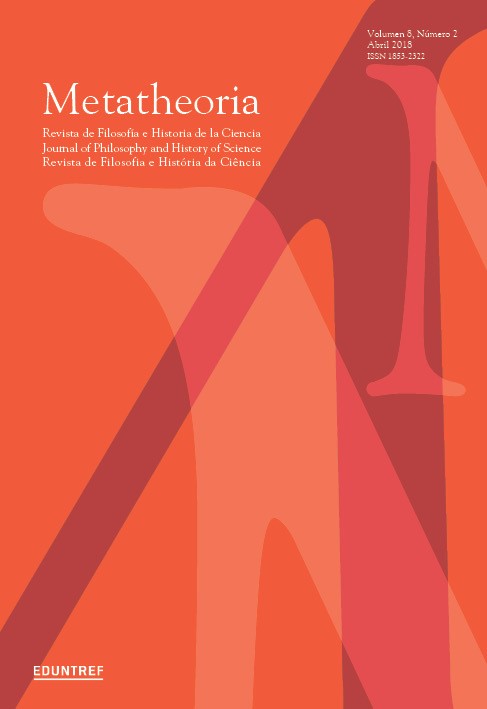Mirror Neurons: Physiological Requirement for Emotional Empathyand Social and Moral Behaviour Of Human and Nonhuman Primates
DOI:
https://doi.org/10.48160/18532330me8.172Keywords:
philosophy of biology, evolutionist epistemology, emotional empathy, mirror neuronsAbstract
Based on scientific evidence and studies achieved by researchers as Rizzolatti, Sinigaglia, Gallese, Goldman, Iacoboni, etc., this paper argues that link between mirror neurons and emotional empathy becames corroborated by Neuroscience studies about perceptive activity and emotional responses. And in particular by Damasio’s contributions about certain brain damages and its effects in emotional activity, in social skills and damaged patient’s cognitive evaluation ability before and after damage. Latter, the paper checkssome plausible inferences about role accomplished by neuron mirror activity and intersubjective empathy experience in development of social behaviour with strong moral implications, as cooperation, altruism and solidarity. The paper ends considering some objections suggested against function and relevance of mirror neurons in emotional empathy experience and development of social behaviour.
References
Adolphs, R., Tranel, D. y A. Damasio (2003), “Dissociable Neural Systemsfor Recognizing Emotions”, Brain Cognition52: 61-69.
Aziz-Zadeh, L., Wilson, S., Rizzolatti, G. y M.Iacoboni (2006), “Congruent Embodied Representations for Visually Presented Actions and Linguistic Phrases Describing Actions”, Current Biology16: 1818-1823.
Brass, M., Schmitt, R., Spengler, S. y G.Gergely (2007),“Investigating Action Understanding: Inferential Processes versus Action Simulation”, Current Biology17(24): 2117-2121.
Chartrand, T. y J. Bargh (1999), “The Chameleon Effect: The Perception–Behavior Link and Social Interaction”, Journal of Personality and Social Psychology76(6): 893-910.
Calder, A., Lawrence, A. y A. Young (2002), “Impaired Recognitionand Experience of Disgust Following Brain Injury”, Nature Neuroscience3: 1077-1078.
Casile, A. (2013), “Mirror Neurons (and Beyond) in the Macaque Brain: An Overview of 20 Years of Research”, Neuroscience Letters540:3-14.
Damasio, A. (2005), En busca de Spinoza. Neurobiología de la emoción y de los sentimientos, Barcelona: Crítica. Fogassi, L., Ferrari, F., Gesierich, B., Rozzi, S., Chersi, F. y G. Rizzolatti (2005), “Parietal Lobe: From Action Organization to Intention Understanding”, Science308: 662-667.
Gallese, V. (2006), “Intentional Attunement: A Neurophysiological Perspective on Social Cognition and its Disruption in Autism”, Brain Research1079(1): 15-24.
Gallese, V. y A. Goldman (1998), “Mirror Neurons and the Simulation Theory of Mind-Reading”, Trends in Cognitive Sciences2: 493-501.
Hutchison, W., Davis, K., Lozano, A., Tasker, R. y J. Dostrovsky (1999), “Pain-Related Neurons in the Human Cingula-te Cortex”, Nature Neuroscience2: 403-405.
Iacoboni, M. (2009), Las neuronas espejo. Empatía, neuropolítica, autismo, imitación o de cómo entendemos a los otros, Madrid: Tecnos.
Kohler, E., Keysers, Ch., Umilta, A., Fogassi, L., Gallese, V. y G. Rizzolatti (2002), “Hearing Sounds, Understanding Actions: Action Representation in Mirror Neurons”, Science297(5582): 846-848.
Krolak-Salmon, P., Hénaff, M., Isnard, J., Tallon-Baudry, C., Guénot, M., Vighetto, A., Bertrand, O. y F. Mauguière (2003), “An Attention Modulate Response to Disgust in Human Ventral Anterior Insula”, Annals of Neurology53: 446-453.
Nichols, S. y S. Stich (2003), Mindreading: An Integrated Account of Pretence, Self-Awareness, and Understanding Other Minds, Clarendon Press: Oxford University Press.
Oztop, E., Kawato, M. y M. Arbib (2013),“Mirror Neurons: Functions, Mechanisms and Models”, Neuroscience Letters540:43-55.
Rizzolatti, G. y C. Sinigaglia (2006), Las neuronas espejo. Los mecanismos de la empatía emocional, Barcelona: Paidós.
Schienle, C., Stark, R., Walter, B., Blecker, C., Ott, U., Kirsch, P., Sammer, G. y D.Vaitl (2002), “The Insula is Not Specifically Involved in Disgust Processing: An fMRI Study”,Neuroreport13:2023-2036.
Singer, T., Seymour, B., O’Doherty, J., Kaube, H., Dolan, R. y Ch. Frith (2004), “Empathy for Pain Involves the Affective but Not Sensory Components of Pains”, Science303: 1157-1162.
Spaulding, S. (2012),“Mirror Neurons are not Evidence forthe Simulation Theory”,Synthese189: 515-534.
Wicker, B., Keysers, Ch., Plailly, J., Royet, J., Gallese, V. y G. Rizzolatti (2003), “Both of Us Disgusted in My Insula: The Common Neural Basis of Seeing and Feeling Disgust”, Neuron40: 655-664.
Downloads
Published
How to Cite
Issue
Section
License
Copyright (c) 2018 Metatheoria – Journal of Philosophy and History of ScienceThe documents published here are governed by the licensing criteria
Creative Commons Argentina.Atribución - No Comercial - Sin Obra Derivada 2.5 https://creativecommons.org/licenses/by-nc-nd/2.5/ar/





